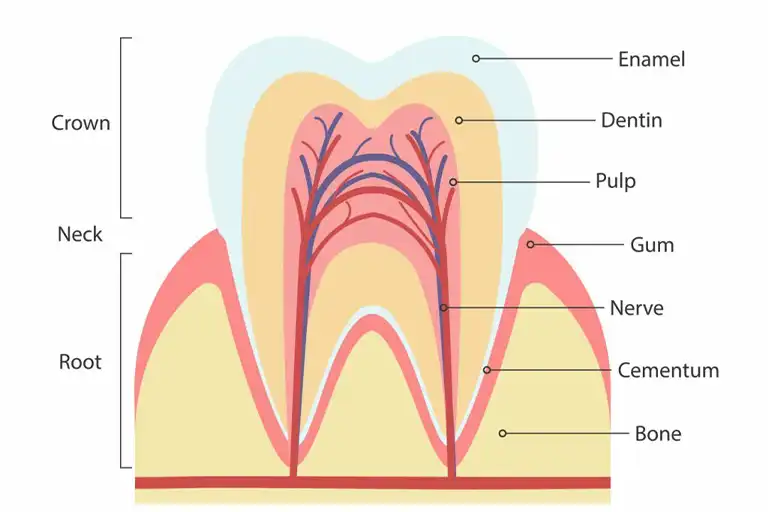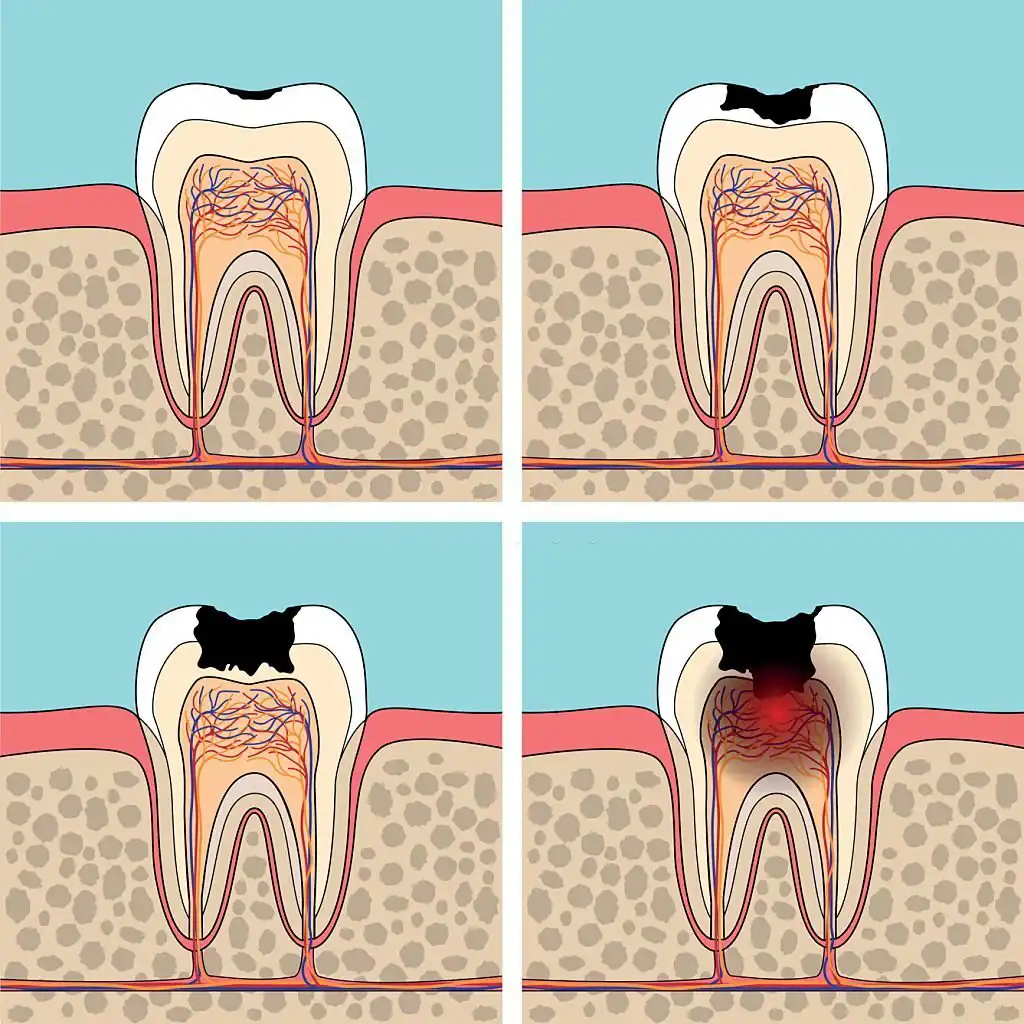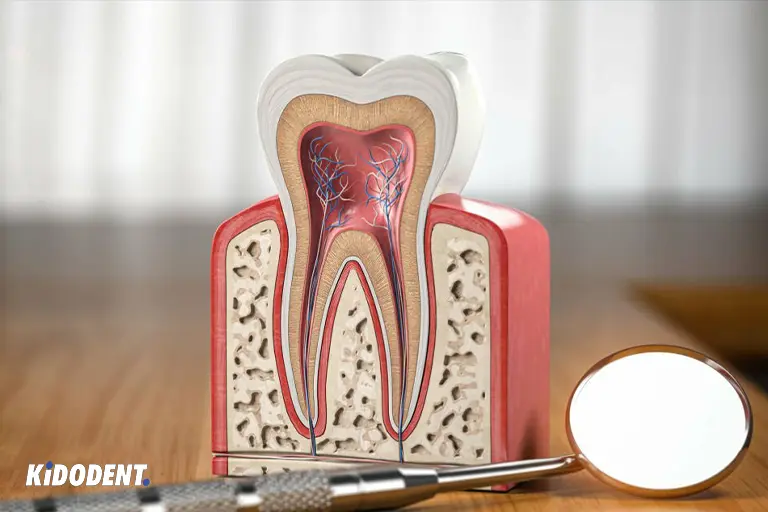To the center of each tooth, there is a soft and vital part which is called tooth pulp or dental pulp. It is protected by harder outer layers and can become exposed when your tooth is damaged by tooth cavities or cracks. An exposed tooth pulp leads to an infection and requires prompt treatment. In this article, you will find out about the function of tooth pulp and its inflammation or disease.
What is tooth pulp?
Simply, tooth pulp is what you can call the brain of your tooth since it keeps your tooth alive and healthy. It contains blood vessels, nerves, highly specialized cells, and connective tissues. Tooth pulp resides inside your tooth in the pulp chamber and continues down through the root canal.
There are outer mineral structures that will protect the pulp. The tooth enamel is the hardest and outermost layer. Beneath the enamel is dentin, the second layer. It is interesting to know that one of the most important functions of dental pulp is to produce dentin. The cementum is a layer under your gums that covers and protects the roots of your tooth.
Cavities or dental injuries like cracked tooth, chips, and teeth grinding (bruxism) can damage the teeth structure and expose the pulp of your tooth. This means bacteria getting in and infecting your pulp.

What is the function of the tooth pulp?
The dental pulp is a unique tissue and has some key functions, including:
Sensory functions. The nerves in the dental pulp allow you to sense pain of a trauma as well as temperature (thermal) changes and pressure,
Creation of dentin. The pulp contains odontoblast cells which will make dentin. These special cells also have a role in the formation of enamel during teeth development.
Nutrients and moisture. Your tooth pulp provides the dentin with nutrients and moisture through blood vessels to keep it healthy. It also manages the blood flow during inflammation.
What are the symptoms of a tooth pulp damage?
If something is wrong with your tooth, the pulp is the first line of defense showing symptoms like pain or sensitivity. However, symptoms can vary depending on the stage of the condition. When bacteria invade the pulp, it results in inflammation or pulpitis, which is often the result of tooth decay.
The most common symptoms of possible damage to dental pulp are:
- Toothache
- Pain when eating or with pressure on tooth
- Sensitivity to hot and cold
- Sensitivity when eating sweet foods
If left untreated, infection worsens in your pulp, causing serious symptoms and life-threatening conditions. The infection can spread to other parts of your mouth and body. A serious infection in the pulp can cause:
- Dental abscess (pocket of pus)
- Bad breath
- Changes in the color of the tooth
- Fever
- Swollen lymph nodes
- Swelling in surrounding parts near the infected tooth like your cheeks
- Brain abscess
- Sinus infection
It is important to see your dentist as soon as possible if you have any symptoms that can indicate a problem with your dental pulp. Your dentist or endodontist can do examinations and perform a root canal treatment to restore the tooth. Otherwise, they may have to extract the tooth if it cannot be saved.
Although dentin forms a rigid wall and major tissue over the pulp, it is less mineralized than enamel. So, when unprotected, it can easily stimulate the nerve (pulp) as you eat or drink something hot or cold, causing you pain.
What are the conditions that affect tooth pulp?
The conditions or diseases that affect your pulp are pulpitis, pulp necrosis, and dental pulp calcification.
Pulpitis
Pulpitis is the name for inflammation of your tooth pulp. It occurs when bacteria invade the pulp through damaged enamel or cementum passing dentin which in turn causes infection. Tooth decay is the most common cause of pulpitis. However, injuries like cracked or chipped tooth and chronic teeth grinding (bruxism) are some other risk factors that can cause an infection.

The two types of pulpitis are reversible and irreversible. Reversible pulpitis is mild inflammation and the pulp can still be saved. You may have mild symptoms of pain or sensitivity. But if your pulp is severely damaged, this is when irreversible pulpitis has occurred.
Irreversible pulpitis leads to pulp necrosis or death of your pulp. Although your dentist or endodontist may perform a root canal to remove the pulp, there can be a situation with no choice but to completely remove your tooth.
Pulp necrosis
Pulp necrosis refers to the death of your pulp in the tooth. At this stage, you may not feel pain or discomfort as the nerve dies. Pulp necrosis can result in dental abscess or the formation of a pocket of pus, which can be life-threatening. Left untreated, a dental abscess is a serious condition that can spread to other parts of your body.
Dental pulp calcification
Increased mineralization in the pulp is known as pulp stones or calcification. Although the exact cause of pulp stones is not known, it is often associated with trauma or aging. You may not show any symptoms if you develop pulp stones. However, it can make root canal treatment challenging if the tooth gets infected.
